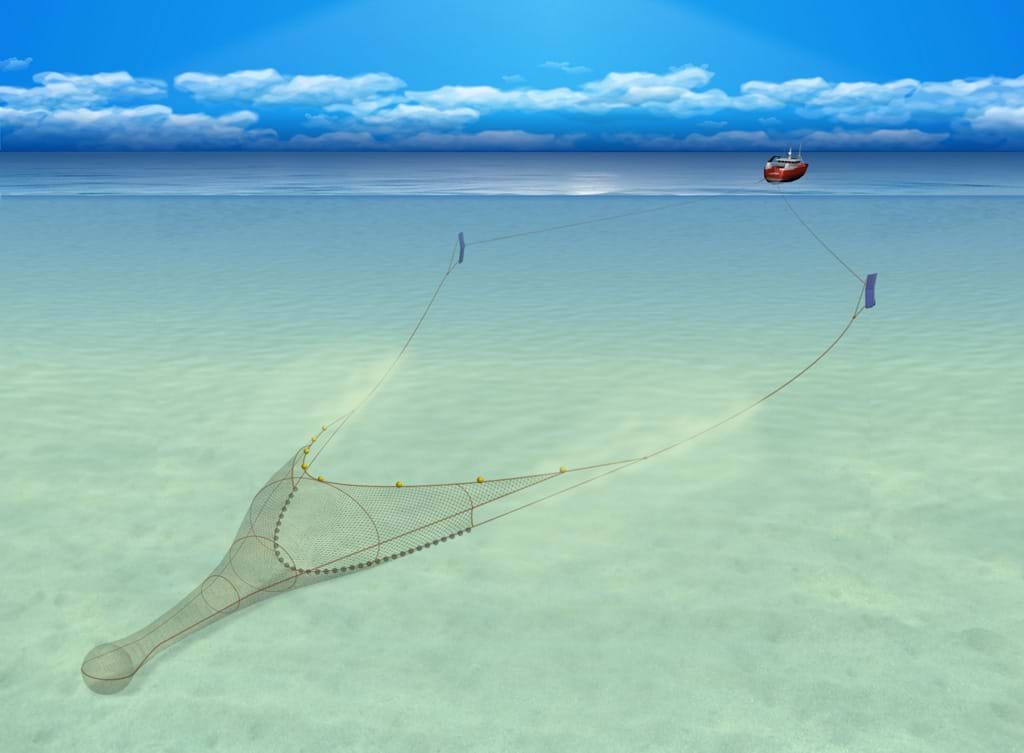Semi-Pelagic Trawl
Alternative names
-
- off bottom trawl
Summary
A trawl that is towed on or very close to the seabed with the trawl doors swimming several metres off the seabed. Some times the trawl is rigged to be skimming just clear of the seabed. In some fisheries a pelagic style of trawl is used in this scenario to target demersal fish.

Environmental impact
In this type of trawling the trawl doors are lifted off the seabed, this eliminates all the seabed impact from the trawl doors. Usually the net is still in contact with the seabed but it will be light on the seabed minimising its impact on the seabed and reducing the by-catch of benthos.
Because the trawl doors are not in contact there is less drag in the gear reducing fuel usage. Generally the trawl doors used in this rig have a higher aspect ration than traditional demersal trawl doors thereby are more efficient, leading to further fuel savings.
Similar selective devices to those used in the usual demersal trawl can be used in a semi pelagic trawl to reduce unwanted by-catch and minimise discarding can be used
Other information
Recently, in several fisheries around the world, skippers and trawl door manufacturers have been working on ways of operating the demersal trawl doors actually flying above the seabed, rather than on it, to decrease the gear’s impact on the seabed, and further reduce the overall drag of the gear. This is often referred to as ‘off bottom doors’, ‘flying doors’ or ‘semi-pelagic trawling’. In this method they generally use a standard high lift demersal trawl and the trawl is actually on the seabed and it’s the trawl doors that are lifted off the seabed.
This has been made easier to achieve by the development of a trawl door that can operate in contact with the seabed and completely off the seabed in mid water. These trawl doors tend to be midway between the traditional pelagic door and a traditional demersal trawl door. The main characteristic is that they are usually designed with multiple hydrodynamic steel foils helping to make them more stable when not in contact with the seabed. This also results in an increase in the spreading force and efficiency of the door. They also they tend to have a higher aspect ratio than a traditional demersal door helping to make them more efficient and suitable for use in mid water.
The modern acoustic sensors designed to give the skipper accurate parameters of his gear in the water have helped this method to develop. The manufacturers have developed specialist sensors to tell the skipper exactly how high his gear is off the seabed at all times. These will also tell him the angle of pitch and roll of the doors.
This method is being used by several overseas trawlers but has yet to be taken up by UK trawlers. However a similar method of ‘semi pelagic trawling’ has been operated by fishermen in Northern Ireland for many years to target cod and haddock. In this method, they use a pelagic trawl and pelagic trawl doors, but rigged it so that the trawl is skimming just clear of the seabed.
Documents
-
Investigation of Reports of Semi-Pelagic White Fish in the Clyde
-
‘Off-bottom’ trawling techniques for the sustainable exploitation of non-pressure stocks in Cornish inshore waters
-
Reducing Seabed Contact of Trawling: Design and model test of a semi-pelagic shrimp trawl for the pink shrimp fishery
Gear classification
Main target species (UK)
-
- Cod
- Haddock
- Hake
- Higher Swimming Fish
- John Dory
- Whiting
Possible bycatch
-
- Any demersal species
- Juveniles of the target species